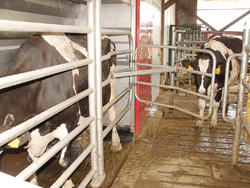June 24, 2010 at 9:16 a.m.
Jon's son, Joe Moulton, told a reporter he opted not go into the family farming business but instead followed a career path in computers and I-T. Lo and behold computer knowledge is now an integral asset for this farming family that's been breaking ground literally for decades in the fields. They are now plowing technological ground using robots.
About 320 cows are currently milked in this herd, just outside of Rush City, but hopes are the herd size will grow significantly mainly due to efficiencies in managing the animals.
The Moultons installed six Lely "Astronaut" milking stations around January. The stall-sized enclosures anchor the midsection of a large barn. There are four robot stations open to one side and two open to the other side of the structure housing expensive electronics, milk testing and processing equipment.
In switching over to this process there was a learning curve for man and beast, Moulton explained. The cows caught on pretty fast as to how the whole thing works. "They like to eat and they like to get milked," he quipped.
A couple cows will need to be "pushed" or convinced they need milking, he continued, but the oddly comforting thing about viewing this system was how contented the cows appeared. Not prized for their sense of fairness nor their manners, these dairy cows had the run of a football field-sized open barn, but stood and waited their turn and ambled through their robot station.
So, how does the system know it's the cow's turn to be milked?
The process is controlled by a microchip the cow wears on a collar. The robot station reads the chip and if the cow hasn't been milked too recently, the udder will be scanned by a beam that resembles a contour laser device surveyors use, and the teats located. The teats are scrubbed by soft brushes attached to a robot arm that looks like a mini-car wash.
It's very important to keep the business part of the cow clean, so bacteria doesn't enter the milk supply and to avoid infections, etc. Moulton said each cow gets tested as it's milked, and the contents from any one cow can be "dumped" by the machine before it gets to the farm's milk tank and contaminates it. Having to dump a tank is very costly.
A cow registering a bad test is then noted by the computer through its chip, and not milked again until the information can be analyzed, and action taken by the herd manager.
The cow's chip also contains information telling the next robot arm-- the suction cups-- where to position for milking. You can watch as the suction device sends the milk into clear piping and eventually to main storage. Product isn't exposed to air.
Meanwhile the cow chews on grain from the bin or semi-naps while its swollen udder shrinks.
The cow exits the station when it has been milked, the rear gate opens and the next cow enters and the process runs through again, and again and again.
Doing this the old fashioned, manual way average dairy farmers get half the milk that the robot operation has been processing, the reason being the cows are free to seek their own milking at anytime. Moulton also said additional efficiencies are found in immediate testing and record keeping by computer.
There are a few animals that simply want to snack, however, and the robot is way ahead of them.
Cows looking to nibble at the grain bin are at the mercy of their chip; that informs the computer they were already milked recently. They get a buzz from an electric wire. The girls get a little huffy, but the exit gate swings open and they move on.
The Lely company says the Astronaut system was invented in 1992. There are over 1.5 million milkings done on a daily basis using this equipment now. About 9,000 systems are operating worldwide but the Moulton Farm is the only one installed locally.





Comments:
Commenting has been disabled for this item.